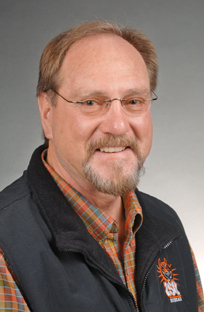Intermountain Center for Educational Effectiveness creates curriculum, helps Idaho’s K-12 educators
October 29, 2009
Idaho State University's Intermountain Center for Educational Effectiveness (ICEE) in the College of Education is changing the way teachers teach.
The ICEE in collaboration with eastern Idaho School districts is defining classroom instructional objectives based on Idaho K-12 content standards and conforming to the No Child Left Behind Act.
This is just one of several major grant projects the ICEE is currently working on.
 "One of the most important projects the ICEE is working on now is the Total Instruction Alignment (TIA) project," said Chuck Zimmerly, ICEE interim director. "We’re working on defining just what classroom instruction should look like for each content standard within four content areas – math, science, social science and language arts. It is a big deal for the way we teach."
"One of the most important projects the ICEE is working on now is the Total Instruction Alignment (TIA) project," said Chuck Zimmerly, ICEE interim director. "We’re working on defining just what classroom instruction should look like for each content standard within four content areas – math, science, social science and language arts. It is a big deal for the way we teach."
To complete the TIA project the ICEE has brought in teachers from throughout Southeast Idaho and had them work in grade level teams to translate standards defined by the Idaho State Department of Education and define just how each standard translates into classroom instruction.&sp;
"TIA provides the teachers with a usable document that helps them focus on specific standards and key vocabulary," said Dr. Barbara Taylor, superintendent for Preston School District #52.
Dr. Ron Bolinger, superintendent of American Falls School District #381, also voices for the value of these studies and their results.
"The TIA program has been crucial in the planning of instruction for our teachers," Bolinger said. "The process for teachers in making decisions in instruction of what to teach to comply with the state standards is extremely important."
The TIA process used by the ICEE is based on that of professional education consultant Lisa Carter who has written several books on the process. Carter defines the TIA as a process "ensuring that what we teach, what we assess and how we teach are congruent."
In this model, there are three steps for creating an effective learning environment for students: alignment of the system; alignment of standards, curriculum and assessment; and alignment of instructional practices in the classroom, according to Zimmerly.
"The results of our TIA work will potentially have a great impact on not only what K-12 teachers in Idaho school districts teach, how they teach, and how to measure the effectiveness of what they teach, but most importantly on increases in student achievement" Zimmerly said. "This is a prime example of the unique collaboration the Intermountain Center for Educational Effectiveness has with Southeast Idaho school districts. The amount of collaboration between an institution of higher education and local school districts we have is unusual, unique and a national niche."
In the past calendar year the ICEE has been involved with completing more than $1 million in grants and research studies, the results of which benefit teachers and students throughout the region.
Another way the ICEE is working with local and statewide school districts is through a Teacher Evaluation Model Pilot grant in which the Center is working with six Southeast Idaho districts to develop consistent teacher evaluation models that can be used throughout the region and, eventually, the state.
"With the input from teachers and administrators we are developing an actual evaluation model that will be implemented and we will train administrators to use," Zimmerly noted. "It is very important to have a consistent manner for evaluating teachers to help ensure the quality of education in a given school or district."
Both the Total Instruction Alignment and Teacher Evaluation Model Pilot projects are funded for about $95,000 each and will be completed in September 2010.
The ICEE also received an $87,000 extension to its Highly Qualified Teachers contract that runs through September 2010. This contract helps the ICEE mentor middle school teachers to meet qualification requirements outlined in the No Child Left Behind Act, in part, by training them and coaching them on successfully completing the Praxis II content area examinations. The Praxis II test measures knowledge of specific content subjects (math, language arts, science, and social studies) that K–12 educators will teach. "It is a very difficult, comprehensive and demanding test," according to Zimmerly. Passing the Praxis II content area tests is a necessary component for a teacher to be deemed Highly Qualified and employable.
Last December, the ICEE was awarded a $682,000 Idaho Building Capacity contract funded by the Idaho State Department of Education to assist schools who failed to meet "Adequate Yearly Progress" in the last four years. Restructuring in this case primarily refers to curriculum and its delivery. Once again restructuring is a requirement of the No Child Left Behind Act of 2001.
Managing and completing grants is only a portion of what the ICEE does. For example, from fall 2008 through summer 2009, the ICEE delivered 5,919 professional development credits to 4,411 students, generating $284,040 in fees. In the last calendar year the Center also offered seven conferences and workshops. It has regular outreach programs with the League of Schools, comprised of 13 school districts in Southeast Idaho; the Idaho Department of Education Region IV, comprised of 22 school districts in South-central Idaho; and IDE Region VI, comprised of 19 school districts in northeastern Idaho.
Categories:

